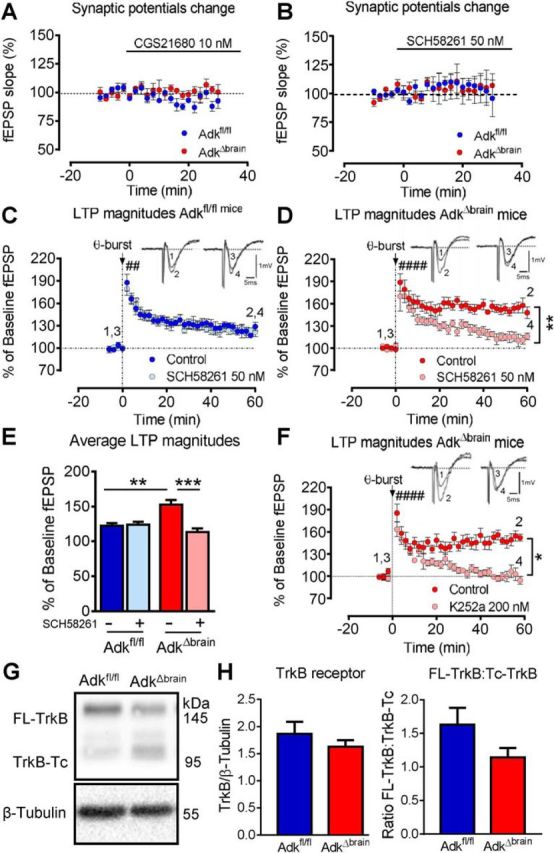Figure 6.

AdkΔbrain mice show enhanced A2A and TrkB receptor- dependent LTP. A, B, The A2AR-selective agonist CGS21680 (10 nm) and antagonist SCH58261 (50 nm) does not affect the fEPSP slope in Adkfl/fl and AdkΔbrain slices (n = 4 mice/genotype/drug). C–E, SCH58261 restores normal theta-burst (3 × 3)-induced LTP in AdkΔbrain mice. C, D, Average change in fEPSP slopes in the absence versus presence of SCH58261 in Adkfl/fl (C) and AdkΔbrain (D) slices (n = 5 mice/genotype/drug). E, Percentage of change in the fEPSP slopes recorded at 52–60 min after LTP induction. F, The TrkB inhibitor K252a (200 nm) restores normal theta-burst (3 × 3)-induced LTP in AdkΔbrain slices (absence: 150 ± 6.7% vs presence: 101 ± 7.0%, n = 5 mice each,). Insets in C, D, and F are representative traces of six consecutive responses composed of the stimulus artifact, presynaptic volley, and fEPSP obtained before (1, 3) and after (2, 4) the theta-burst stimuli in the absence (1, 2) and presence (3, 4) of drug. LTP was significant (####) after theta-burst stimuli versus baseline (C, D, F). G, Representative blot of full-length TrkB receptor (FL-TrkB, 145 kDa), truncated TrkB receptor (TrkB-Tc, 95 kDa), and β-tubulin (55 kDa, loading control) is shown. H, Averaged immunodensities of TrkB receptor normalized to β-tubulin and the ratio of FL-TrkB to TrkB-Tc (n = 8 mice/genotype). Results are presented as mean ± SEM. 100% corresponds to the averaged fEPSP slope recorded 10 min before LTP induction. *p < 0.05, **p < 0.01, ####p < 0.0001.
